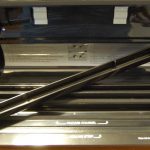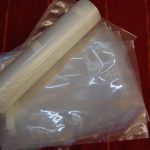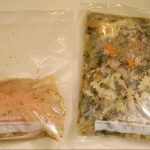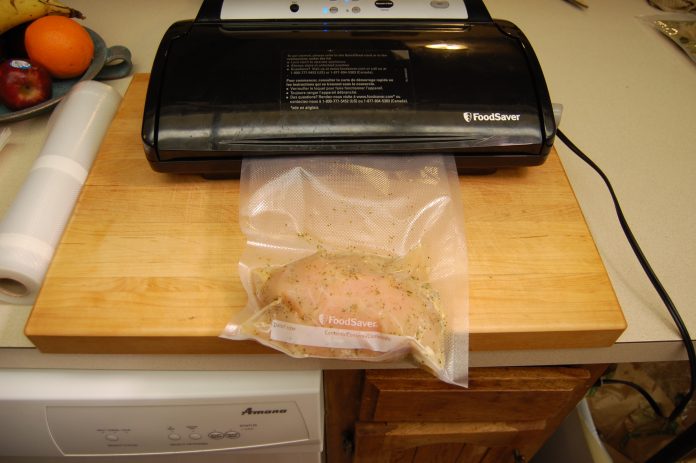When most people are asked why they picked up “take out” on the way home their response is simple: “I didn’t have anything to cook.” With the addition of one gadget in your kitchen you can rectify the single biggest reason people don’t cook: access to food at home.
Vacuum Sealers Get Small
One of the most important tools in the small kitchen is the vacuum sealer. It is usually marketed as a cost savings device, allowing for buying in bulk and then freezing off. It is also marketed as a way of getting food “in season” then freezing. Although the latter is a good enough reason to own one I am a big fan of vacuum packing simply to be organized.
It is true that any meat counter will pack up a single chicken breast, a couple of bratwurst, or a half a pound of bacon for you in a freezer pack. However, the tray and butcher paper method used by most meat counters isn’t a great way to freeze meat. Second, what this leaves you with is a series of brown or white packs of unrecognizable food teetering in a frozen stack at the back of your already crowded freezer. Add a couple of quarts of ice cream (admit it, you have ice cream in your freezer), an old bag of frozen peas, and two tupperware containers of chili that you swore you were going to eat and it is no wonder that take out sushi from the deli area of the mega mart starts to look attractive rather than rummage through that mess. The problem isn’t the food. The problem is the way it is packed.
Vacuum packing in small quantities allows those of us living by ourselves or in pairs to take our smaller freezer and make good, organized, but most importantly accessible use of the area. It also allows us to, on occasion, make the pot of chili or grandma’s “special” pinto bean soup and freeze off the leftovers in flat, manageable serving packs. In other words, forget using a vacuum sealer to “save money” with buying in bulk. It is your ticket away from mediocre strip mall sushi.
Tools for the Job

Vacuum sealers are readily available in any department store or online. They range in price from $70-$120 depending on brand name and features. In general most of us in the smaller household don’t need anything fancy or large. We need the basic sealer that will seal food in clear, simmer use, bags.
When buying a vacuum sealer look first for a removable vacuum channel. This is the area that any excess liquid will be sucked into during the sealing process. If the vacuum channel is removable it will make the sealer very easy to clean. After all, some liquid may get “sucked” into this channel during the sealing process. So if you can pull the channel out you can clean it quickly and replace it. Ease of cleaning equals ease of use. And the number one reason people don’t use appliances will always be some version of “it was too fussy.”
The second thing to look for in a vacuum sealer is a “wet/dry” setting. Most of the food we will seal will be “wet”. However, some people like to seal dry things, like coffee or spices. If you want to do those kind of products look for a sealer with that setting.
The last choice to be made is what type of bags to use. Most sealers have rolls that store inside the sealer, allowing us to make any size bag we want. Rolls generally allow for larger storage and tend to be less expensive. However, for one or two people the pre-sized bags are very convenient. Like standard storage bags, they come in various sizes and are quick and easy when you are putting up recent purchases.

NOTE: No matter what bags you buy make sure that they are capable of a wide variety of uses. They should read something like: safe for refrigerator, freezer, microwave, and simmering.
Vacuuming Food
The first and foremost rule is to follow the manufacturer’s directions for your style of vacuum sealer. In general they all work the same but each model may have different quirks. Here are some general tips about sealing:
- With liquids like soups don’t look to get all of the air out. There may be a pocket or two of air after the seal. This is common and will not be there after you lay the bag flat in your freezer to freeze.
- When filling roll the top of the bag back about an inch and a half. Put your food in then wipe the created rim off with a clean towel before sealing. By making a rim the bag is easier to fill and it helps ensure you don’t over fill.
- Speaking of overfilling, don’t do it. It is far better to waste a little plastic instead of getting the bag in the freezer and having it leak all over.
- When freezing meats freeze what you need only. Again, when in doubt, waste the plastic. You may think you want two chicken breasts at a time but if you don’t know freeze them separately. One of the goals of vacuum sealing our purchases is to put our food in usable quantities. Saving money by buying when on sale is secondary.
- After you seal the bag wipe the area between the heat seal and the bag opening again with a clean cloth. During the vacuum process there may be some spillover (which will show up in the easy to clean removable channel).

Chicken breast and soup ready to freeze after vacuum sealing
Storing
The vacuum sealers greatest asset is its ability to freeze flat. I happen to really like soups and I like making them. I always have enough for a bag or two to be sealed and frozen. As stated above, my bags are simmer ready so I just put my bag in a pot of hot water. However, I could also remove the soup in the morning, thaw in the fridge, then heat stovetop or in a microwave safe dish. Over all, it is way better than a can of processed…well…anything.

As for meat storage nothing is more convenient than vacuum sealing. You can have one half a pound of ground round or ground turkey and make tacos for one or two easily and without left overs. One half a chicken breast, depending on the appetite, these days will feed two people. And don’t neglect things like ham, sausage, or bacon. For a weekend at home breakfast or brunch you can pull out half a pound of sausage or bacon rather than figuring out how you are going to use up all of that sausage roll.
Bottom line
The bottom line with vacuum sealing for our size households isn’t, really, about saving money. Certainly it can be used for that and nothing beats using the vacuum sealer to take advantage of seasonal items that are too expensive or unavailable off season. However, the best thing about vacuum sealing is how easy it makes cooking. Food is stackable in our freezers and since plastic is see through our food is also easy to locate. Butchers, even if they “freezer” wrap, don’t package things in see through plastic.
If you don’t have a vacuum sealer I recommend that you get one. If you do have one pull it out and rediscover how convenient they are for packaging food. Putting food in quantities that we need and doing the work up front (right when we come home from the grocery) helps us use what we’ve purchased and eat at home more. Staying home for our meals…real meals that are cooked and not take out…helps keep our bodies, our attitudes, and above all our spirits healthy.
Chris







